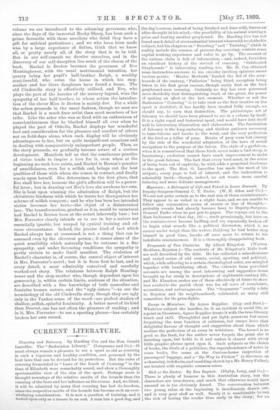CURRENT LITERATURE.
Coursing and Falconry. By Harding Cox and the Hon. Gerald Lascelles. The "Badminton Library." (Longmans and Co.)—It must always remain a pleasure to see a sport so old as coursing in such a vigorous and healthy condition, and governed by the best laws that can be devised for its protection. But the rules of coursing formulated in Laws of the Leash of Coursing" in the time of Elizabeth were remarkably sound, and show a thoroughly sportsmanlike view of the aim of the sport. Perhaps more is thought nowadays of the relative merits of the hounds than the running of the hare and her influence on the course. And, we think, it will be admitted by many that coursing has lost its freedom, since the respective merits of the hounds has become such an over- whelming consideration. It is now a question of training, and is looked upon only as a means to an end. A. man has a good dog, and the day's course, instead of being finished and done with, leaves an after-thought in his mind,—the possibility of his animal winning a prizo and beating another greyhound. Mr. Harding Cox has not found much detail of circumstantial interest wherewith to clothe his subject, but his chapters on "Breeding ' and " Training," which in reality include the essence of present-day coursing, contain some capital working experience and rules to go by. The account of the various clubs is full of informations—and, indeed, furnishes an excellent history of the revival of coursing. "Celebrated Greyhounds" is interesting reading, too. Mr. H. Cox obtained some instructive answers to his circular inviting opinions anent various points. 'Master McGrath' headed the list of the grey- hounds of the century, 'Fullerton' being third, exception being. taken to his first groat success, though easily first as the best greyhound seen running. Certainly no dog has ever possessed more decidedly that distinguishing mark of the great, the power of making an effort at the last moment. Whether or not the Badminton "Coursing" is to take rank as the first treatise on the sport is doubtful ; it has hardly been treated fully enough, we should say, to earn that distinction. The picturesque art of falconry we should have been pleased to see in a volume by itself.. It is a right royal and historical sport, and would have lent itself well to interesting illustration and elaboration. The fascination of falconry is the long-enduring and tireless patience necessary to tame falcons and hawks to the wrist, and the very perfection of the bird as a killer of prey. Beasts of prey seem but clumsy by the side of the wonderful adaptation of the laws of aerial navigation to the purpose of the falcon. The style of a gyrfalcon, when it is remembered that these birds never make a bad stoop, is fascinating ; evolution cannot have much improvement to make in the groat falcons. The fact that every bird must, in the sense of being born out of captivity, be wild, adds a perpetual freshness to the sport. The Hon. G. Lascelles has made the most of his subject ; every page is full of interest, and the instruction is admirably lucid,—though, indeed, no art wants more careful tutoring and more delicate management.


































 Previous page
Previous page